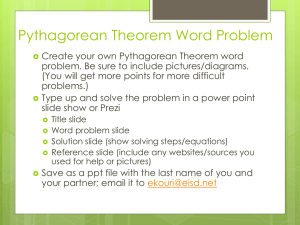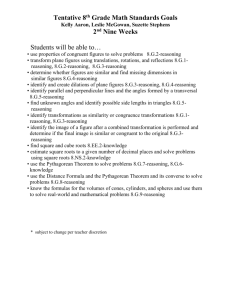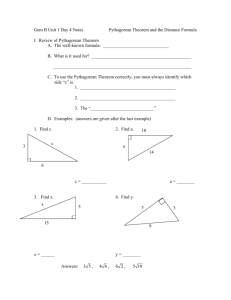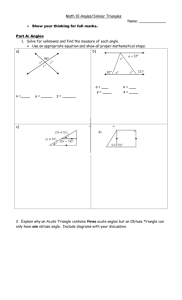Applied Right Triangles
advertisement
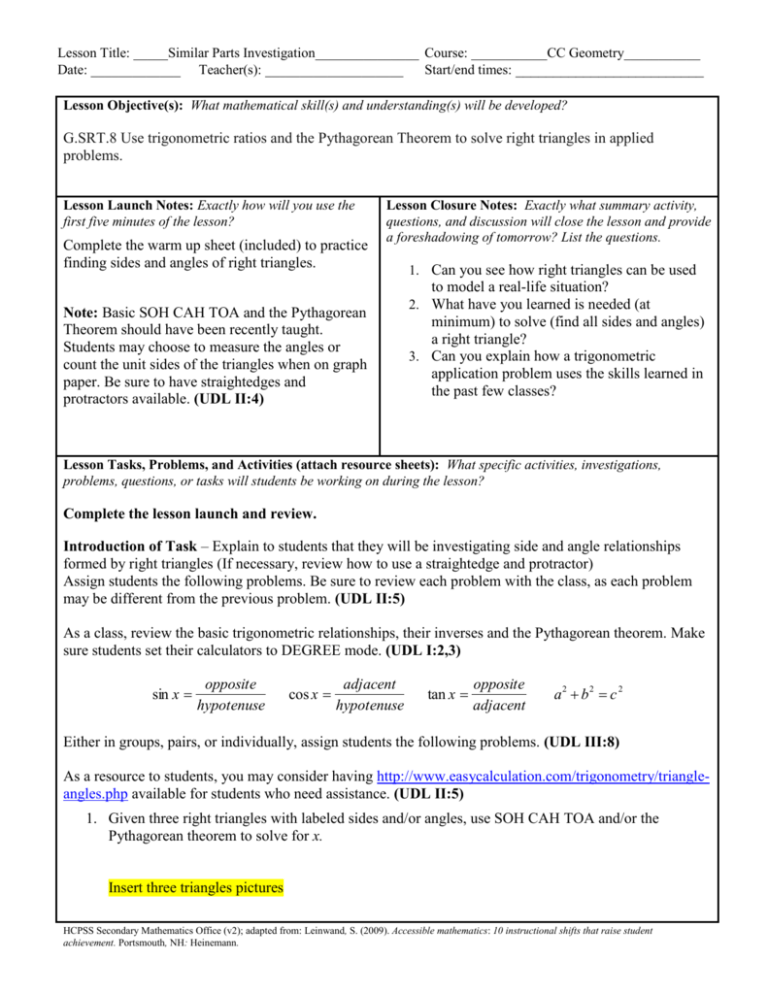
Lesson Title: _____Similar Parts Investigation_______________ Course: ___________CC Geometry___________ Date: _____________ Teacher(s): ____________________ Start/end times: _________________________ Lesson Objective(s): What mathematical skill(s) and understanding(s) will be developed? G.SRT.8 Use trigonometric ratios and the Pythagorean Theorem to solve right triangles in applied problems. Lesson Launch Notes: Exactly how will you use the first five minutes of the lesson? Complete the warm up sheet (included) to practice finding sides and angles of right triangles. Lesson Closure Notes: Exactly what summary activity, questions, and discussion will close the lesson and provide a foreshadowing of tomorrow? List the questions. 1. Can you see how right triangles can be used to model a real-life situation? Note: Basic SOH CAH TOA and the Pythagorean Theorem should have been recently taught. Students may choose to measure the angles or count the unit sides of the triangles when on graph paper. Be sure to have straightedges and protractors available. (UDL II:4) 2. What have you learned is needed (at minimum) to solve (find all sides and angles) a right triangle? 3. Can you explain how a trigonometric application problem uses the skills learned in the past few classes? Lesson Tasks, Problems, and Activities (attach resource sheets): What specific activities, investigations, problems, questions, or tasks will students be working on during the lesson? Complete the lesson launch and review. Introduction of Task – Explain to students that they will be investigating side and angle relationships formed by right triangles (If necessary, review how to use a straightedge and protractor) Assign students the following problems. Be sure to review each problem with the class, as each problem may be different from the previous problem. (UDL II:5) As a class, review the basic trigonometric relationships, their inverses and the Pythagorean theorem. Make sure students set their calculators to DEGREE mode. (UDL I:2,3) sin x opposite hypotenuse cos x adjacent hypotenuse tan x opposite adjacent a2 b2 c 2 Either in groups, pairs, or individually, assign students the following problems. (UDL III:8) As a resource to students, you may consider having http://www.easycalculation.com/trigonometry/triangleangles.php available for students who need assistance. (UDL II:5) 1. Given three right triangles with labeled sides and/or angles, use SOH CAH TOA and/or the Pythagorean theorem to solve for x. Insert three triangles pictures HCPSS Secondary Mathematics Office (v2); adapted from: Leinwand, S. (2009). Accessible mathematics: 10 instructional shifts that raise student achievement. Portsmouth, NH: Heinemann. Lesson Title: _____Similar Parts Investigation_______________ Course: ___________CC Geometry___________ Date: _____________ Teacher(s): ____________________ Start/end times: _________________________ 2. Now, using problem 1 as a guide, let’s use a real-life situation to find the height of a flagpole. A flagpole creates a 90o angle with the ground and casts a 24-foot shadow from the sun. If the base angle from the tip of the shadow to the top of the pole is 68o, how tall is the pole? 3. Let’s try another one! This time be sure to carefully read the problem before making any final conclusions. Our school is going green by planting trees along the front sidewalk. For each tree a 10-foot support wire is tied to the middle the tree trunk and staked to the flat ground 8.5 feet away from the base of each tree. If each tree stands vertically, how tall is each tree? Make sure you: Draw a picture Label the triangle Determine which trigonometric ratio or theorem will be used to solve for the unknown Find the answer to the problem. 4. Assisting a local community member, you decide to help them build small barn-style doors for their shed as shown in Figure 2.1. Each door is made by nailing decorative pieces of wood on top of the door. The doors are built on a piece of wood that is 6 feet tall and 4 feet wide. To begin the decoration, you attach a 2-inch border around the whole frame. This is followed by creating an “X” shape on the front of the door (as shown). In order to create this “X” piece of wood you need to cut the wood at certain angles so it will fit in the corners of the door. What angles does the decorative wood create in each corner of the door frame? Find angles A,B,C,D,E,F,G,H as shown in Figure 2.1. Insert FIGURE 2.1 here Review each problem with the class and answer any questions. Complete the Lesson Closure Notes as a class. Complete the Lesson Reflection as a class. Evidence of Success: What exactly do I expect students to be able to do by the end of the lesson, and how will I measure student mastery? That is, deliberate consideration of what performances will convince you (and any outside observer) that your students have developed a deepened (and conceptual) understanding. Students should be expected to be able to take given information and draw a basic sketch of the problem, labeled correctly. HCPSS Secondary Mathematics Office (v2); adapted from: Leinwand, S. (2009). Accessible mathematics: 10 instructional shifts that raise student achievement. Portsmouth, NH: Heinemann. Lesson Title: _____Similar Parts Investigation_______________ Course: ___________CC Geometry___________ Date: _____________ Teacher(s): ____________________ Start/end times: _________________________ Students should be expected to find missing sides or angles in an applied right triangle problem using the basic trigonometric ratios and/or the Pythagorean Theorem. Students should be able to draw conclusions from their work and answers. (UDL III:9) Notes and Nuances: Vocabulary, connections, common mistakes, typical misconceptions, etc. Students should be familiar with the sine, cosine, and tangent trigonometric ratios, as well as the Pythagorean Theorem. Be sure to review the hypotenuse, opposite, and adjacent sides of a right triangle. (UDL I:2) Graphing Calculators must be in DEGREE MODE. Resources: What materials or resources are essential for students to successfully complete the lesson tasks or activities? Calculator Protractor Straight-edge/ruler Graph paper Homework: Exactly what follow-up homework tasks, problems, and/or exercises will be assigned upon the completion of the lesson? (To be determined by the teacher) Lesson Reflections: What questions, connected to the lesson objectives and evidence of success, will you use to reflect on the effectiveness of this lesson? Ask: “How has this lesson shown us how to apply math in real-life situations?” (UDL III:9) HCPSS Secondary Mathematics Office (v2); adapted from: Leinwand, S. (2009). Accessible mathematics: 10 instructional shifts that raise student achievement. Portsmouth, NH: Heinemann.
